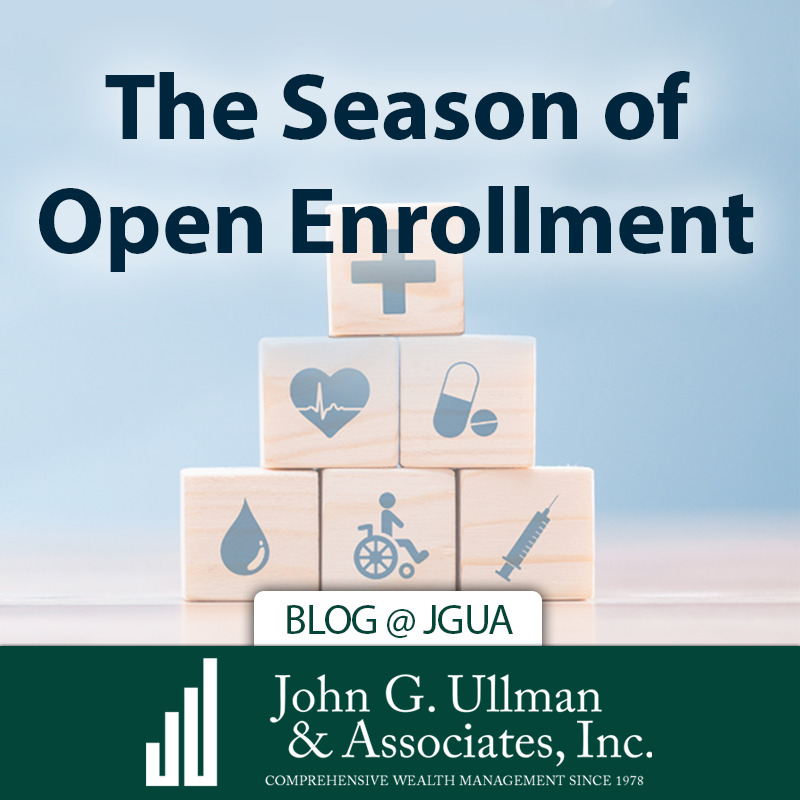While most of us are thinking of pumpkin spice, apple cider, leaf peeping, sweaters, Ugg® boots, and Halloween, we should not forget that many of us have an open enrollment period upon us. During this period, employees can enroll in any number of benefits offered through their employers. Did you know that according to the Bureau of Labor Statistics, benefits make up nearly 1/3 of average total compensation for workers? In this blog we will review some of the most common benefits, what to look at while reviewing them, and some tips for making decisions on what is best for you. Let’s get started so you can get back to your fall fun.
The Insurances
Health, Vision, & Dental
When thinking about open enrollment, this discussion seems to be the most common and the benefit most widely reviewed. Many employers offer a range of health insurance plans that you can choose from. One way to determine what plan would be best for you (and your family) is to review your usage from prior years. You can often choose a high deductible health insurance plan that has lower premiums, but requires that you pay out of pocket for most costs of health care until you meet your deductible. This type of plan can be paired with a Health Savings Account (HSA) that will allow you to save money into a pre-tax account for medical bills as they arise. This type of plan is often best for those who rarely see a doctor and have limited health issues. On the opposite end, there are more comprehensive plans that often have higher premiums, but better coverage. These types of plans would be good for those that see doctors often, have chronic health management issues, or take monthly prescriptions.
In addition, if you are married and both spouses work, now is a good time to review whose company offers a more suitable plan for your situation. This may change every few years and it would be beneficial to review.
A few other items to keep in mind while reviewing your health policy options:
- Is your regular doctor considered in-network or out-of-network?
- Are all of your prescriptions covered under your plan?
- Does your plan have any sort of healthy rewards for exercising?
For dental and vision insurance, the questions are the same. The more comprehensive the plan, the more money it will cost. For those with prescription glasses, contacts, implants, crowns, or even a high sugar diet, looking into a more comprehensive coverage is a good idea.
Short- and Long-Term Disability Insurance
It is more likely for a person to face a serious injury at work than to pass away untimely. Disability insurance is often overlooked, yet can be one of the most beneficial and cheap options for employees. Did you know that disability coverage in NYS is capped at $170 per week? Even if you are a professional pulling in $2,000 per week, you are capped at receiving $170 under NYS Regulations. If your employer offers disability insurance, my recommendation is almost always to get it!
The difference between short-term and long-term disability insurance is merely when it kicks it. Usually there is a waiting period before you are covered and that can be a detriment to a lot of people’s budgets. Short-term disability insurance can have a waiting period of 0-90 days and then benefits generally last 3-6 months, but can pay as long as one or even two years. You will then want the long-term disability insurance to kick in after this time period is up. The waiting period can be as long as 720 days. Set it up so that the long term insurance kicks in after the short term expires. The shorter the waiting period, the higher the premium.
Speaking of premiums, many employers will give you the option to have the premiums taken from your paycheck pre-tax or after-tax. While it may seem instinctual to pay them pre-tax, if you do it that way, then all of your disability benefits will be taxable. If you pay the premiums with after-tax dollars, then your benefits would be tax-free. Usually the premiums are low enough where it makes much more sense to have them taken out after-tax, knowing your benefits would have more value should you ever need to take them.
Life Insurance
The last of the insurances. There are many types of life insurances that employers may offer. Life insurance, spousal insurance, children insurance, accidental death and dismemberment insurance, final expenses insurance, and more. The list goes on. Oftentimes, getting these insurance policies through work can be the cheapest option because it is based on group size. And even better, in many cases, when you leave your employer you have the option to take the life insurance with you (usually at a higher cost). This can ensure that you are eligible for coverage even when you may not be off on your own. Many insurances through employers will not require a physical to enroll through work. If you have a medical issue that may prevent you from qualifying for coverage, then this could be the best way to qualify. The same actually applies for disability insurance as well.
Now, how do you know how much insurance you need when choosing a policy? Let’s take a look at a few of the things to consider when deciding on an amount:
- Do you have any debts that will need to be paid?
- Do you have a spouse or family that will need 1-2 years (or more) of your income to re-adjust?
- Do you have children that may need college tuition in the future?
- Do you have a mortgage that could be paid off?
- Do you want to leave a little extra to keep your family in comfort?
Let’s say Jane and Joe are married with two boys, Tim and Tom, who are 15 and beginning to look for college. Jane makes $150,000 per year and Joe works part time and earns $30,000 per year. They have a mortgage for $100,000 and joint credit card debt of $25,000. Jane also has about $100,000 of student loan debt that her mom cosigned for her. What should Jane consider when getting life insurance to benefit her family?
- With the higher income, she should expect that the survivors may need 3-5 years of her salary to adjust. She might want $500,000 for this reason.
- With a mortgage and joint credit card debt of $125,000, she should add that to the total.
- She could get an additional amount to cover both boys’ college tuitions estimating $100,000 each.
- Since her mom is a cosigner on her student loans, her mom will be liable for $100,000 if Jane passes away.
Looking at that fact pattern, Jane may want to get a policy through work that has $925,000 or more in coverage to cover all of her basis. She can make sure her family is covered, left with no debt, and some adjustment room. In addition, her mom won’t be saddled with Jane’s school loans.
Voluntary Benefits
HSA vs. FSA
There are really two ways you can pay for medical expenses on a pre-tax basis. The first is a Health Savings Account, or HSA, and is only available (as mentioned above) to those with a high deductible health insurance plan. The second is a Flexible Spending Account, or FSA, and is available to all employees.
In 2021, a family can contribute up to $7,200 into an HSA, while an individual can contribute $3,600. These contributions are pre-tax and can be withdrawn tax and penalty free for qualified medical expenses. In addition, the HSA can also be used as a tax-deferred savings or investment account if you don’t need to use it for medical expenses. It can then be withdrawn penalty free for any expenses after the age 59 ½. You will owe taxes on it at the time of withdrawal if not for medical expenses.
The FSA, on the other hand has a contribution limit of $2,750 for medical expenses and $10,500 for families with dependent care FSAs. Or $5,250 for single filers. You don’t pay taxes on these funds. That is the major benefit of an FSA. The catch with an FSA is that the money does not roll over each year. It has a “use it or lose it” caveat, so you want to make sure you are not putting more into it than you need to spend. Any excess is forfeited. Most employers allow a grace period to use the funds until March of the following year, but some do not, so check with your employer! If they don’t you have to use it by December 31st each year.
Miscellaneous Benefits
Some employers offer unique benefits, and as the workforce changes, the priority of these benefits are shifting as well. Keep an eye out for the following being offered through your employer:
- Gym Memberships
- Commuter Benefits
- Travel Benefits
- Tuition Reimbursement or Student Loan Help
- Pet Insurance
- Legal Coverage
Lastly, now is a great time to review your retirement contributions, investment choices, and account performance. While you can change all of this as often as your plan allows, using open enrollment as the trigger to review each year is a good practice.
In summary, take the time to review how your benefits can benefit you! And do it all with an apple cider donut and pumpkin latte in your hand.







